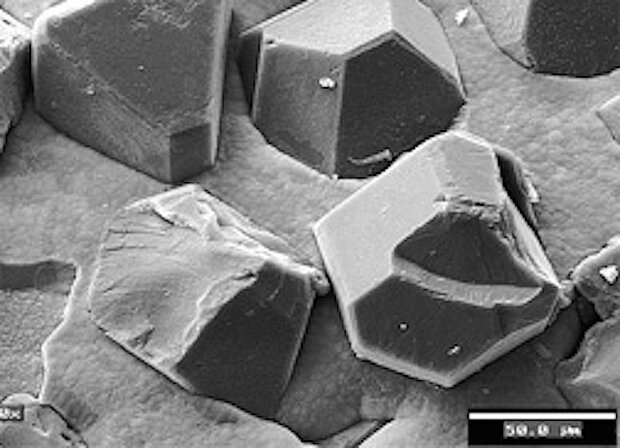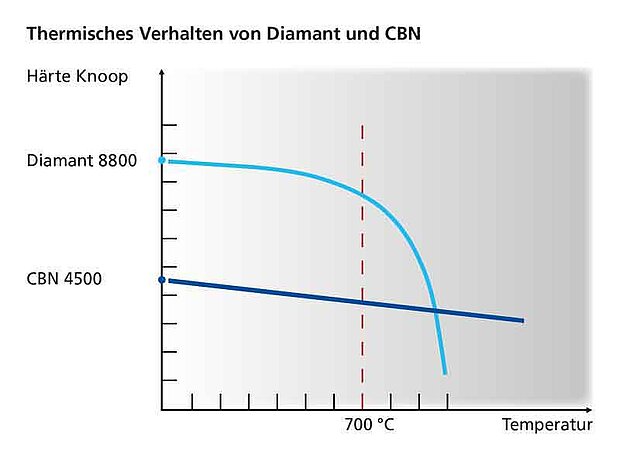Diamond (PCD)
Diamond is pure carbon in a crystalline arrangement. He has in comparison to other abrasives, such. As CBN, corundum or silicon carbide a much greater hardness and thus a greater resistance to mechanical wear. At high temperatures above 800 degrees Celsius, diamond reacts with atmospheric oxygen to form carbon dioxide, literally dissolving in air. Diamond has a reactivity on contact with ferrous materials, which leads to the transformation into graphite. Due to the high temperatures during the grinding process, steel removes carbon from the diamond. This decomposes the diamond abrasive grain. Diamond tools are therefore not suitable for machining steel.
There are three types of diamond used in the cutting process:
Monocrystalline diamonds correspond in their structure to natural diamonds, but are manufactured artificially. They are ideal for polishing acrylic glass to a high gloss. The polycrystalline diamonds (PCD) are - similar to the production process of cemented carbide - sintered at high temperature and high pressure from numerous single crystals into a solid body. They can be used for milling and polishing work. CVD diamond thick-film plates are built up in layers by chemical vapor deposition from thin layers and then cut into shape by a laser beam. The result is a very homogeneous diamond structure and an extremely smooth cutting edge for highest surface qualities.
Despite their higher purchase price, diamond tools are the more economical alternative for many machining tasks - not least because of the possibility of regrinding them several times.
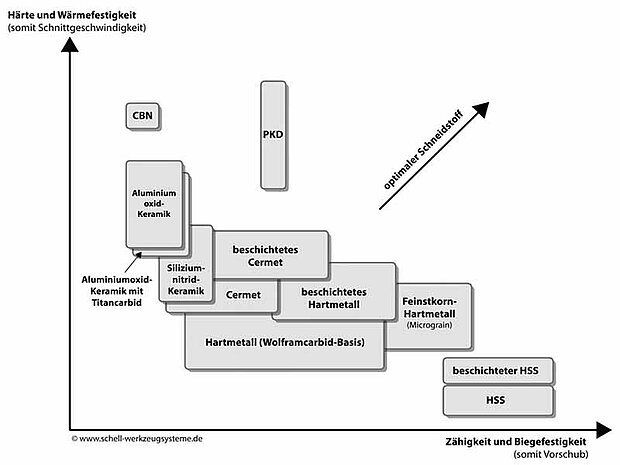
The most common cutting materials in comparison
Relation between hardness (thus cutting speed) and toughness (thus feed) of cutting materials in comparison (please click on the picture left):
Overview of the most common cutting materials for drilling, turning and milling: PCD, CBN, alumina ceramics, silicon nitride ceramics, cermet, carbide, micrograin, HSS.
Cubic boron nitride (CBN)
<p>Cubic boron nitride (CBN) is the second hardest substance after diamond today. With a Knoop hardness of 45 GPa at room temperature, CBN is the second hardest material after diamond (88 GPa). CBN is made from boron and nitrogen in a high pressure and high temperature process similar to diamond synthesis, with the chemical name c-BN. CBN differs from synthetic diamond (PCD) in its <b>superior thermal stability </b>. Above 900 ° C CBN is thus the hardest known material.</p>
<p> The reason for this is the property of the CBN to form a protective boric oxide layer at high temperatures under an oxygen atmosphere. In addition, because CBN contains no carbon, unlike diamond, it is suitable for machining hardened and unhardened carbon steels. When using diamond, increased wear occurs in this material group due to tribochemical reactions. This also applies to the machining of titanium and its alloys. Reasons for this are the increased reactivity of titanium with oxygen and the tendency to form carbides. In many applications, cubic boron nitride is preferred over diamond because it is stable in air up to temperatures of 1400 ° C. Diamond begins to decompose at 800º C. An important property compared to PCD is thus <b>the chemical resistance to ferrous materials </b>.</p>
<p> Compared to conventional abrasives (corundum, sintered corundum SK, silicon carbide SIC), CBN offers advantages when grinding hard-to-machine steels (hardness> 55 HRC). Due to the low grinding wheel wear, high dimensional and dimensional accuracy can be more easily maintained. <b> CBN ground tools are also characterized by a longer service life</b>, as the cool grinding CBN hardly influences the edge zone structure of the workpiece.</p>
<p>As can be seen from the adjacent illustration, there is a significant advantage of CBN over diamond in thermal stability. While diamond suffers a massive loss of hardness at about 700 ° C, the hardness of CBN remains almost unchanged even at more than 1000 ° C.</p>
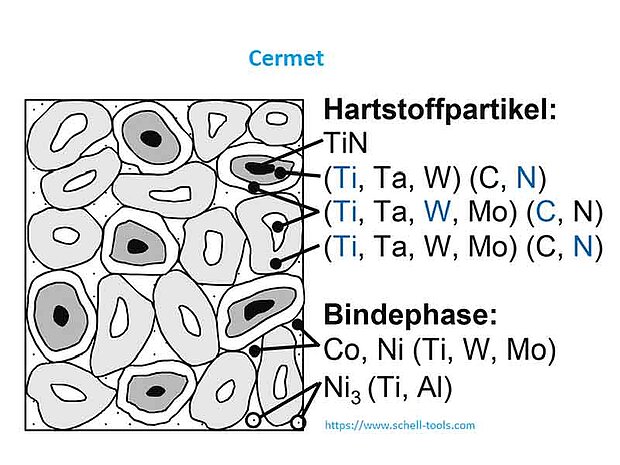
Cermet
Cermets (composed of English: ceramic and metal) are composites of ceramic materials in a metallic matrix (binder). They are characterized by a particularly high hardness and wear resistance. Originally it was a combination of TiC and nickel. Modern cermets are nickel-free and feature a core particle structure of titanium carbonitride Ti (C, N), a second hard phase of (Ti, Nb, W) (C, N) and cobalt as a binder. Ti (C, N) gives the grade resistance to wear, the second hard phase increases resistance to plastic deformation, and the cobalt determines toughness.
Cermet has better wear resistance and less tendency to stick than carbide. On the other hand, it has a lower pressure and heat resistance. Cermets can also be PVD coated for higher wear resistance.
Cermet cutting materials are used wherever the material to be processed tends to stick which inevitably leads to build-up on the cutting edges. Their self-sharpening wear pattern keeps the cutting forces low even after long cutting times. In sizing operations, this extends the service life and allows tight tolerances and glossy surfaces. Typical applications include stainless steels, ductile iron, low carbon steels and ferritic steels. Cermets are also the solution for all ferrous materials.
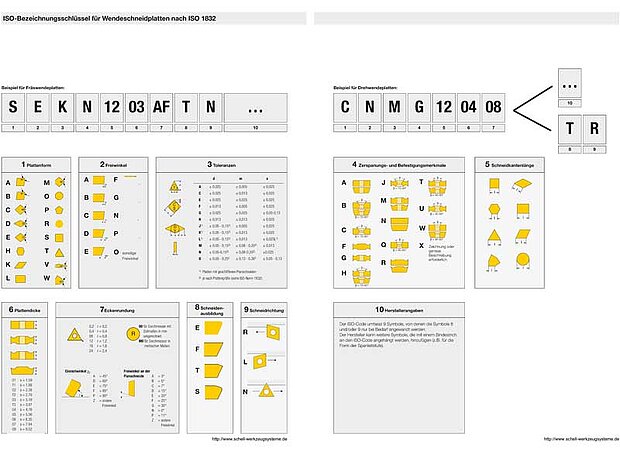
Indexable Inserts ISO Designations
The International Standard ISO 1832 contains a code for designating the usual types of indexable inserts made of hard cutting materials or other cutting material for cutting tools, in order to simplify the ordering and the specifications of these inserts.
Also specified are the symbols for the designation of cubic boron nitride or cubic boron nitride (BL, BH, BC) inserts as well as inserts coated with polycrystalline diamond (DP).
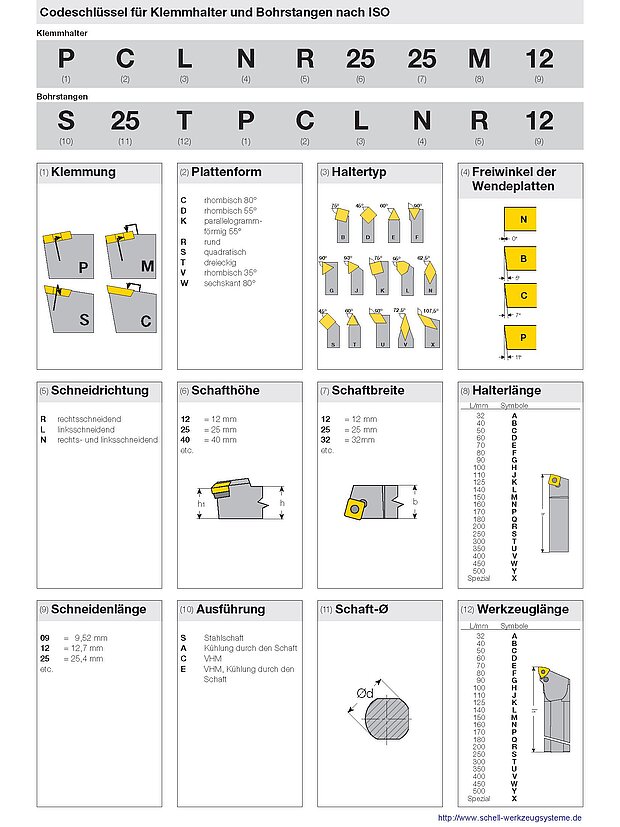
ISO code clamp holder with square shank for indexable inserts
The specifications in DIN ISO 5610-1 concerning the shape and assignment of the dimensions apply to those specified in DIN ISO 5610-2 to DIN ISO 5610-15 standard clamp holder with square shank designed to accept indexable carbide, ceramic or other cutting materials used in turning machining.
The specifications for clamp holder with square shank are in accordance with International Standard ISO 5610: 2014. This standard has been prepared by Working Committee NA 121-01-12 AA Turning and Drilling Tools with Hard Cutting Material Inserts in the DIN Standards Committee Tools and Clamping Tools (FWS).

